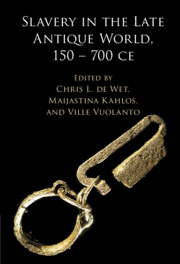Book contents
- Slavery in the Late Antique World, 150–700 CE
- Slavery in the Late Antique World, 150–700 CE
- Copyright page
- Contents
- Figures
- Tables
- Contributors
- Preface
- A Note on Abbreviations and Sources Used
- Introduction Late Antique Studies and the New Polyphony for Slave Studies
- Part I Moral and Symbolic Values of Slavery
- Part II Slavery, Cultural Discourses, and Identity
- 5 Slavery in Euphemia and the Goth
- 6 What Was Jewish about Jewish Slavery in Late Antiquity?
- 7 Divining Slavery in Late Ancient Egypt: Doulology in the Monastic Works of Paul of Tamma and Shenoute
- 8 Rural Slavery in Late Roman Gaul: Literary Genres, Theoretical Frames, and Narratives
- Part III Slavery, Social History, and the Papyrological and Epigraphical Sources
- Part IV Social and Religious Histories of Slavery on the Borders of the Empire and Beyond
- Bibliography
- Index
5 - Slavery in Euphemia and the Goth
from Part II - Slavery, Cultural Discourses, and Identity
Published online by Cambridge University Press: 27 January 2022
- Slavery in the Late Antique World, 150–700 CE
- Slavery in the Late Antique World, 150–700 CE
- Copyright page
- Contents
- Figures
- Tables
- Contributors
- Preface
- A Note on Abbreviations and Sources Used
- Introduction Late Antique Studies and the New Polyphony for Slave Studies
- Part I Moral and Symbolic Values of Slavery
- Part II Slavery, Cultural Discourses, and Identity
- 5 Slavery in Euphemia and the Goth
- 6 What Was Jewish about Jewish Slavery in Late Antiquity?
- 7 Divining Slavery in Late Ancient Egypt: Doulology in the Monastic Works of Paul of Tamma and Shenoute
- 8 Rural Slavery in Late Roman Gaul: Literary Genres, Theoretical Frames, and Narratives
- Part III Slavery, Social History, and the Papyrological and Epigraphical Sources
- Part IV Social and Religious Histories of Slavery on the Borders of the Empire and Beyond
- Bibliography
- Index
Summary
Located somewhere between ancient fiction and Christian hagiography, the story of Euphemia and the Goth recounts the tale of a young girl from Edessa, Euphemia, whose widowed mother, Sophia, is deceived and manipulated into letting an unnamed Gothic soldier marry her daughter. Later, as the story develops, events take a turn for the worse, and the pregnant Euphemia is taken away to the Goth’s homeland, only to find that he is already married. She is then given as a slave to the Goth’s wife, and suffers terrible abuse before being miraculously rescued.
The story is set in ca. 395 ce Edessa, in the context of the invasion of Mesopotamia by the Huns, although possibly composed decades later in the fifth century. As in some other cases from Syriac literature, Euphemia and the Goth reads in many ways like a tale from the genre of the Greek novel.
Keywords
- Type
- Chapter
- Information
- Slavery in the Late Antique World, 150 – 700 CE , pp. 107 - 128Publisher: Cambridge University PressPrint publication year: 2022

